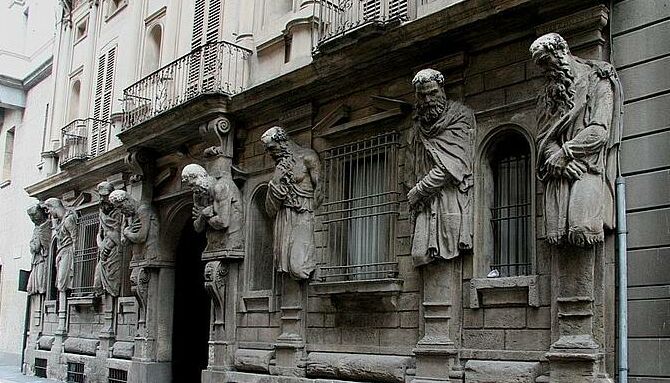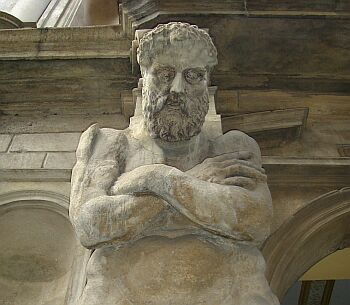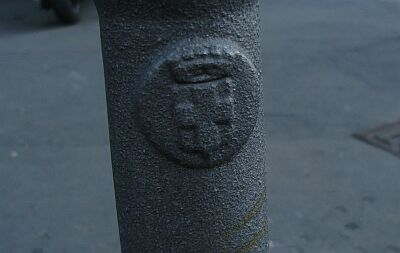When Justine and I left Italy to come to New Zealand, my parents gave us a little bundle of heirlooms, including one that had nothing to do with the family or its history in a direct sense: a small ancient Roman oil-lamp. Its value isn't monetary, nor aesthetic - it is dirt-encrusted and the handle is broken, the little spout chipped, in parts of the country you could find dozens just like it if you knew where to dig - but to me it has come to symbolise continuity and family and home in a way that few other things could. Nowadays we keep it next to a photo of my father in the closest thing we have to a little shrine.
Now that I'm back as always I am forced to ask myself what it is that makes me miss the old, very old and downright ancient stuff that one finds more or less lying around the place. All the more so since Milan lacks the obvious charm of so many other Italian cities, and a good deal of our old stuff isn't of the variety that makes the tourists flock and the cash register ring. Our most iconic building, the Duomo, is a hodgepodge of styles and took centuries to complete - apparently the good people of the city, fond as they have always been of enterprise and commerce, harboured some reservations about the value of its chief monument. The other star attraction, Leonardo's Last Supper, started to peel off the wall when it was barely finished, and the monks who had commissioned it duly proceeded to cut a door through it, just so they could get from the dining hall to the kitchen more quickly. All for the sake of open plan living, you see.
So the city has a less than enthusiastic relationship with its heritage, and perhaps ten years ago I did too. But now I find myself far more attached to the urban landscape than I was, smog-covered warts and all. One could blame the nostalgic sentimentality of a migrant, and I'm sure that it's at least partly the case. But being away also means looking for ways to remain connected, and not just through the magic of Skype, indispensible as that is; one also longs for a sense of place, and for the aura and physical touch of objects that have been around for some time, enough to see the local history unfold around them, as it were. Me, I especially like these eight dudes:
The {Omenoni}, or big men, have been around since 1565, tucked away in a little street behind Piazza della Scala, quietly observing the human traffic, their porous stone getting impregnated with the sooty dust that we've all been breathing. Like so many of my favourite corners of Milan, they are quirkier than they are charming or beautiful in the traditional sense. They are also solid and hard-working, so they fit in well with the local ethos. And one cannot help feeling sorry for them. Joseph wanted to take a picture of the one that seemed the saddest:
Not surprisingly, the young fella is fascinated by the surroundings, and has been full of questions that I've been somewhat over-zealously attempting to answer - having the whole "the Romanesque comes before the Gothic period" conversation with a seven year old ought probably to be regarded as a form of abuse. So oftentimes he lets me drone on while he busies himself taking pictures. I don't think he necessarily does it in order to look at them again in the future - it is simply part of his way of looking. And, like most children his age, he likes to focus on the unlikely details, such as cobblestones or the embossed coat of arms of the city on a cast iron post.
Naturally his pictures, far more than mine, are the ones that capture that ineffable essence of place that makes my memory tingle; shots that I wouldn't have bothered to frame because their individual parts are unremarkable if not downright ugly, but that taken together make up postcards of the Milan that I know - a city that hasn't aged as gloriously as some others, and is more well-worn than it is pretty. Not unlike our humble oil-lamp, encrusted with a past that is not ours, but that speaks to us, and becomes an object to remember with, to think of the people and the ways of being and doing that came before.
Mum's house is full of such objects, thanks in part to the heroic frugality of past generations: I'm thinking especially of the square knife that my grandmother used to cut tagliatelle with, made from the recycled blade of an old scythe, and at least two packs of cards that my parents shuffled into oblivion playing patience in the evening, and that my mother uses to this day, insisting that she has no trouble at all counting the seven diamonds on the settebello through her cataracts. And good on her, perhaps some day I'll do the same.
Giovanni Tiso



